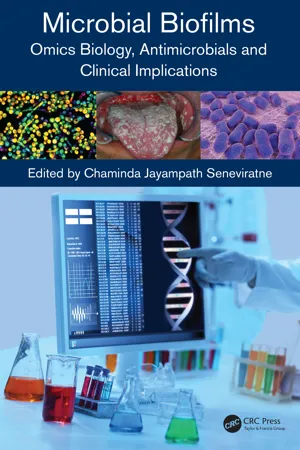
Microbial Biofilms
Omics Biology, Antimicrobials and Clinical Implications
Chaminda Jayampath Seneviratne, Chaminda Jayampath Seneviratne
- 274 pages
- English
- ePUB (adapté aux mobiles)
- Disponible sur iOS et Android
Microbial Biofilms
Omics Biology, Antimicrobials and Clinical Implications
Chaminda Jayampath Seneviratne, Chaminda Jayampath Seneviratne
À propos de ce livre
Microbial Biofilms: Omics Biology, Antimicrobials and Clinical Implications is a comprehensive survey of microbial biofilms and their role in human health and disease with contributions from world renowned experts in molecular microbiology, proteomics, genomics, metabolomics and infectious diseases. The book is intended to serve as a guide for students, as well as a reference for researchers, clinicians and industry professionals. The chapters cover bacterial and fungal microbiomes, and the latest omics techniques organized in a clear and up-to-date manner. One of the highlights of this book is the comprehensive information on "omics of microbial biofilms". The chapters dedicated to metagenomics, proteomics and metabolomics are designed to provide a simple and holistic review of the current knowledge and, the applications of these techniques in the field of microbial biofilms. In addition to introductory chapters on microbial biofilms and their clinical implications, subsequent chapters delve into oral biofilms, their composition, and metagenomic diversity. Thereafter, mechanisms of drug resistance in microbial biofilms are reviewed, as well as the proteomic and metabolomic characterization of this resistance. The book includes a comprehensive discussion of persister cells and host–microbial interactions on mucosal surfaces. Finally, the book concludes with a summary of novel therapeutic approaches for biofilms such as synbiotics and biogenics.